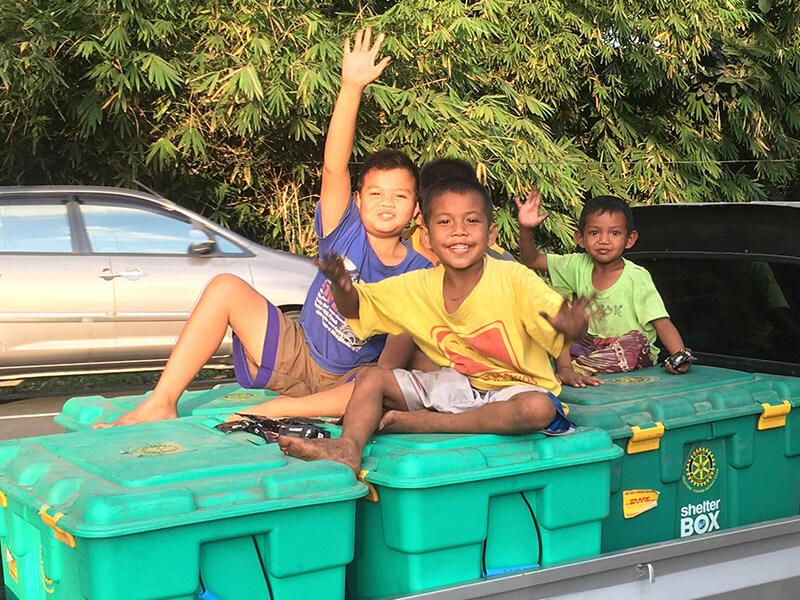On Friday 28 September, the people of Sulawesi looked on in horror as giant waves crashed onto their shores.
First the island was hit by a 7.5 magnitude earthquake. Then a tsunami tore through the region, flattening everything in its path and turning thousands of homes to rubble.
Families have been left devastated as they struggle with the catastrophic aftermath. Thousands are still searching for lost family members, whilst also enduring landslides and power outages.
We’re sending a response team to understand how we can help Sulawesi families who have lost everything. But our resources are limited after an unprecedented stream of disasters this year.
Right now, our teams are stretched across the globe, responding to natural disasters in the Philippines and Kenya, as well as operating in Syria, Iraq, the Lake Chad Basin and Somalia.
We rely on our incredible supporters to fund our vital work providing shelter in times of disaster. We’re impatient to respond – wherever we’re needed in the world – but we need your help.
How Are We Helping?
This is the latest in a series of earthquakes to hit Indonesia.
We already have a ShelterBox team on the island of Lombok, helping families recover from the 6.9 magnitude earthquake which hit in August.
The team is working with our local Rotary contacts to deliver aid to families in Lombok who lost everything in the quakes. So far we have helped over 360 families across North and West Lombok.
In addition to providing tents, tarpaulins, ropes, kitchen sets, blankets, ground sheets, mosquito nets, and solar lights, we have also provided tents to maternity and postnatal clinics.
Now, in the aftermath of the earthquake and tsunami in Sulawesi, we are hoping to help many more families. We’re sending a highly trained team, whose key focus will be to look at if and how we can best help the families affected.

TSUNAMIS 101
WHAT IS A TSUNAMI?
A tsunami is a series of large often catastrophic ocean waves. Tsunamis should not be confused with Tidal Waves, these are waves generated on the surface of the ocean by wind, tidal pull from the moon and the position of the earth.
WHY DO TSUNAMIS HAPPEN?
The large waves that form a tsunami happen when there is an earthquake under the ocean. Other things can make tsunamis too, such as volcanic eruptions, sub-marine rockslides or a large impact in the water from an asteroid or meteor.
Water will move in all directions from the location of the disturbance, starting small and gradually getting larger and larger.
WHAT ARE THE EFFECTS?
When waves caused by the underwater disturbance reach land, they will be far faster and more powerful than regular ones. They also grow in size as they approach the shallow waters near land.
These large, powerful waves can destroy buildings, roads, railways, and pretty much anything else in their path. Tsunamis can destroy whole communities leaving many people homeless and destroying their livelihoods.
Clean drinking water will be contaminated and individuals affected often lose their possessions.
EARTHQUAKES 101
WHAT IS AN EARTHQUAKE?
An earthquake happens when pieces of the earth’s surface rub together, causing the ground to shake.
WHY DO EARTHQUAKES HAPPEN?
Although the ground we walk on may seem solid, it is actually made of huge pieces of flat rock which together, create a kind of patchwork.
These flat pieces of rock are called plates and are constantly moving, although this usually happens so slowly we don’t even notice.
Sometimes these plates get stuck and pressure builds up until one of the plates is forced to give way – this can cause the ground across a wide area to vibrate violently.
WHAT ARE THE EFFECTS?
The size of an earthquake is usually measured by a system called the ‘Richter Scale’. Earthquakes that measure below 4 on this scale are unlikely to cause any damage and those below 2 will usually not even be felt.
However, earthquakes above 5 on the Richter Scale will cause damage and those above 7 are considered major earthquakes. These larger earthquakes can result in buildings being destroyed or so badly damaged they are too dangerous to live in.
WHAT ARE AFTERSHOCKS?
Aftershocks are earthquakes that follow the largest shock of an earthquake sequence.
They are smaller than the initial, main earthquakes and within 1-2 rupture lengths distance from the mainshock.
Aftershocks can continue over a period of weeks, months, or even years. In general, the larger the mainshock, the larger and more numerous the aftershocks, and the longer they will continue.
WHAT IS LIQUEFACTION?
Liquefaction is a phenomenon which causes sand and soil to act like a liquid when shaken by an earthquake. It tends to happen in places with loose saturated soil, like Palu in Indonesia.
The earthquake reduces the strength of the soil and it starts to flow like a liquid, lifting and carrying homes and buildings along with it. The effects can be devastating.
RESPONDING ALL OVER THE WORLD
We support the most remote communities across the world that have been affected by disaster.
We go the extra mile to find the most vulnerable families whose lives have been devastated by disaster. Our work isn’t done until no family is left without shelter.
